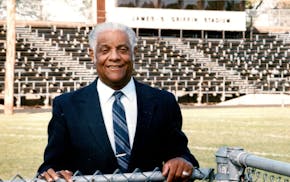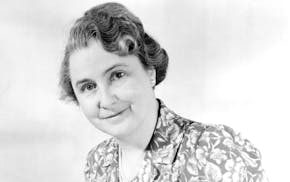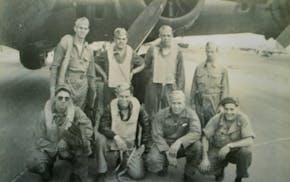A series of small strokes has made speaking tough for 99-year-old Loraine Teninga Plasman, who lives at Founders Ridge senior community in Bloomington.
But an application letter to an aircraft manufacturer she typed up 80 years ago speaks volumes about her heroic spirit amid the dark days of World War II.
"I would like to get into work directly connected with the war effort," she wrote at 19 to the Curtiss-Wright Corp. — explaining that math was "one of my best subjects" and that she had earned Bs in analytical geometry and beginning calculus.
Her pitch worked. Plasman became one of nearly 800 women from across the country who worked as aeronautical engineering "cadettes" for Curtiss-Wright from 1943 to 1945. She became a draftsperson for the company after a 10-month engineering cram course at the University of Minnesota, one of seven universities nationwide participating in a government-backed program to offset shortages caused by male engineering graduates heading into the military.
"That masculine domain — the engineering buildings — is no longer an exclusive haven for men," according to a 1943 issue of Minnesota Technolog, a U engineering magazine. "This is a women's war too, and by being Curtiss-Wright cadettes these coeds are doing their part for Victory."
Born in Chicago, Loraine Teninga thrived in math in high school and went to Wells College in New York with plans to become a music teacher. She was going to transfer to Northwestern University in the fall of 1942, but had to look for work instead when her father's real estate business soured. Then her older sister sent her a New York Times clipping about the Curtiss-Wright program.
Loraine was among "more than 100 excited college girls" who arrived at the U's Shevlin Hall in February 1943, according to the Minneapolis Tribune. The young women faced a grueling class schedule "twice as tough as the ordinary college year," with 40 hours a week of courses in aerodynamics, aircraft drawing, engineering math and sheet metal shop. In addition to tuition and room and board, they received a salary of $10 a week.
A 1979 story marking 50 years of aeronautical engineering at the U gave Plasman and her cohorts credit for another innovation. A "few daring" cadettes decided to wear jeans (instead of skirts) all day rather than just for shop class, "anticipating by about 25 years modern college chic" — and letting them swing their slide rules from their belts just like the guys.
After completing the program in December 1943, Plasman was transferred to a Curtiss-Wright plant in Columbus, Ohio, where she worked as a technical draftsperson on Navy carrier-based bombers known as SB2C Helldivers, according to her son, James, of Madison, Wis.
After the war, the Technolog predicted, some of the U cadettes would finish their college degrees, stay in the field or get married. On her father's advice, Loraine majored in English literature at the University of Michigan. She married Steve Plasman in 1948; when he took a job with Minneapolis-Moline they moved in 1956 to Edina, where they raised three children: James, Barb and Peg.
"When I was younger, I didn't sit still long enough to listen, but my appreciation of what my mother did has blossomed," said Peg Mosier, 68, of Burnsville. "This is huge. She set aside her schooling to contribute to the war cause and save our precious freedom."
In a 1995 interview with the Star Tribune's Chuck Haga, Plasman explained: "I wanted to do something." Her brother had joined the Navy, she said, "and it gave you so much more confidence in yourself to go out and do something in the world."
Now a grandmother of six and great-grandmother of nine, Plasman is among the unsung Americans who did their WWII duty. She's also one of more than 5 million American women who joined the work force during the war. Until then, most female workers were widows or younger single women with no children.
Wartime employment found half the women at work were married with children, according to historian Doris Kearns Goodwin. In her book "No Ordinary Time," she cites a 1940s poll of female workers that asked if they enjoyed working more than staying home. Nearly 80% said they preferred working.
"No way could that have happened to me except for the war," Plasman said in 1995, adding that she still had some of her old war-plane blueprints all those decades later.
When Steve Plasman started a market research business in the 1960s, Loraine served as the firm's bookkeeper and office manager. She was active in the League of Women Voters and at Christ Presbyterian Church, and loved playing bridge and teeing up at Braemar.
"She was always good with numbers," Peg Mosier said. "Even at 99, she points things out when I try to help balance the checkbook."
Curt Brown's tales about Minnesota's history appear every other Sunday. Readers can send him ideas and suggestions at mnhistory@startribune.com. His latest book looks at 1918 Minnesota, when flu, war and fires converged: strib.mn/MN1918.

Minnesota History: Ad man turned Paul Bunyan into a folklore icon

Minnesota History: James Griffin used persistence to blaze a trail for St. Paul's Black police officers

Minnesota History: For Granite Falls doctor who tested thousands of kids for TB, new recognition is long overdue

Minnesota History: A New Ulm baker wearing a blanket fell to friendly fire in the U.S.-Dakota War


